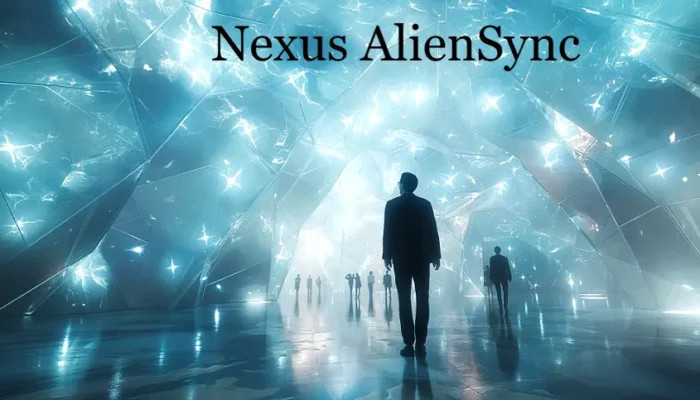
In our increasingly connected world, businesses, devices and platforms are drowning in data—but starving for real-time synchronization, seamless intelligence, and fluid interoperability. That’s where Nexus AlienSync steps in: a platform that promises to unify disparate systems, AI modules, and workflows into one coherent, intelligent ecosystem.
In this article we’ll explore what Nexus AlienSync is (and isn’t), how it works, where it adds value, the benefits and challenges, and why you should keep an eye on it.
What is Nexus AlienSync?
At its core, Nexus AlienSync is a synchronization and integration platform built for the modern digital age. Whereas legacy tools often focus on simple data transfer or scheduled syncs, Nexus AlienSync targets real-time, intelligent synchronization across multiple heterogeneous systems—whether cloud, on-premises, edge, IoT or AI modules.
The name itself hints at the ambition: “Nexus” implying connection or hub, and “AlienSync” suggesting the bridging of unfamiliar, non-standard, even “alien” systems into one synchronized network. One source describes it as “a sophisticated AI orchestration platform that enables seamless communication and collaboration between disparate AI models, systems, and datasets.”
In short: if you run systems that don’t naturally talk to each other—different languages, protocols, devices—Nexus AlienSync aims to serve as the glue, the bridge, the real-time harmoniser.
Why Does It Matter Today?
The case for a platform like Nexus AlienSync becomes clear when you examine three major realities of enterprise and device infrastructure today:
- System fragmentation. Many organisations operate dozens or hundreds of disparate systems—ERPs, CRMs, IoT platforms, machine-learning models, legacy databases. These often run in silos, leading to inconsistent data, duplication, delays. Nexus AlienSync explicitly addresses the “fragmentation” problem.
- Need for real-time intelligence. In sectors such as finance, healthcare, logistics and manufacturing, data must be updated and acted upon instantly. Stale or delayed data can cost money, risk lives, erode competitiveness. Sources highlight that Nexus AlienSync offers “real-time updates”, “instant mirroring”, and synchronization across multi-cloud/edge environments.
- Increasing complexity of tech stack. With AI/ML models, edge devices, mobile, cloud, hybrid environments and IoT joining the picture, the old “one system” view no longer suffices. Integration must be smarter, architectural. The platform touts features like an “intelligent compatibility layer”, “adaptive protocol matching” and “micro-services architecture” to support this complexity.
Because of these factors, a tool like Nexus AlienSync isn’t just nice to have—it may be essential for organisations looking to scale and make better use of their data and intelligence.
How Nexus AlienSync Works: Inside the Mechanism

Let’s unpack the architecture and workflow behind Nexus AlienSync.
Key Components & Workflow
- Connection/Adapter Layer: The first step is connecting various systems—cloud platforms, edge devices, legacy databases, and AI models. Nexus AlienSync uses smart connectors, APIs or even custom adapters depending on the system.
- Translation/Compatibility Engine: Because systems differ (protocols, data formats, languages), the platform converts or standardises data so that one system’s output becomes another’s input seamlessly. This may involve data-normalisation, protocol translation or semantic mapping.
- Sync Manager / Orchestration Layer: Here, events trigger synchronisation—when something changes in one system (data update, new sensor reading, model output), the Sync Manager ensures the change is propagated across relevant connected systems according to rules and logic.
- Monitoring & Control Dashboard: Users can monitor data flows, synchronisation performance, conflicts, errors, latency, resource usage—all via a central dashboard. One source says “Centralized Monitoring and Control” is a key feature.
- Machine-Learning / Adaptive Layer: Unlike older sync tools, Nexus AlienSync uses intelligent modelling: it learns patterns, predicts when synchronisation is needed, resolves conflicts proactively and optimises performance over time.
Typical Workflow Example
- A sensor device in a factory detects a temperature spike.
- That reading is picked up by the adapter layer and routed to the Sync Manager.
- The compatibility engine converts the reading into a format consumable by a data-analytics system and an AI model for predictive maintenance.
- The analytics platform updates its dashboard; the AI model recalculates risk and sends an alert to a mobile app for a technician.
- Meanwhile, the monitoring dashboard shows the data flow, highlights latency (if any) and logs the event for audit.
- Over time the ML layer learns that spikes above a certain threshold always precede failures and begins to pre-emptively push updates.
This end-to-end workflow is the kind of scenario Nexus AlienSync is built for.
Features & Capabilities at a Glance
Here is a summarised table of the major features of Nexus AlienSync and why each matters:
| Feature | Description | Why It Matters |
| Real-time synchronization | Changes in one system propagate instantly to others. | Ensures decisions, dashboards and operations are based on current data. |
| Multi-platform / multi-cloud support | Works across AWS, Azure, Google Cloud, private data centres, edge devices. | Prevents vendor lock-in and supports complex, hybrid infrastructures. |
| Intelligent compatibility layer | Converts data formats, protocols, languages between systems. | Eliminates the cost and time of custom connectors and integrations. |
| Monitoring & orchestration dashboard | Single view of workflows, health, performance, errors. | Enables transparency, troubleshooting and governance in large systems. |
| Machine-learning / self-learning sync engine | Learns patterns to optimise syncs, predict needs, adapt rules. | Reduces manual configuration, improves performance, anticipates issues. |
| Security & compliance built-in | Encryption, audit logs, compliance modules for GDPR/HIPAA (depending on source) | Critical for industries with regulated data (healthcare, finance). |
| Scalable microservices architecture | Each component can scale independently; supports high loads. | Important for growth, peak loads, and global deployments. |
Who Can Use Nexus AlienSync & What Are the Use-Cases?
Because Nexus AlienSync is industry-agnostic yet highly capable, a wide range of organisations can benefit. Here are key sectors and how they apply it:
1. Healthcare
Hospitals, clinics and medical device manufacturers often have many systems: EMRs, imaging systems, wearables, lab systems, pharmacy data. Keeping them in sync is vital for patient safety, efficiency and regulatory compliance. One source states: “Patient records synchronized in real time, eliminating lags caused by manual data input or fragmented systems.”
2. Finance & Fintech
Financial institutions need live transaction data, fraud detection, audit trails, risk modelling and customer profiles. Synchronising data among internal systems, external APIs and analytics models is key. Nexus AlienSync enables this by providing real-time updates, precision and scalability.
3. Retail & Ecommerce
Retailers juggle inventory systems, e-commerce platforms, supply-chain data, customer analytics and marketing. A unified real-time sync means inventory updates propagate immediately, orders reflect in fulfilment, customer interactions are in sync. For example: “Retailers can automate the synchronization of product catalogs, monitor sales data across various channels…”
4. Smart Cities / IoT / Manufacturing
In smart-city or factory-automation scenarios you have sensors, edge devices, analytics, control systems. Real-time data synchronisation across these elements enables predictive maintenance, traffic management, energy optimisation, and more. One write-up noted “Smart cities … connect traffic sensors, environmental monitors … unified dashboard for decision-makers.”
5. Technology & AI Firms
Companies building AI models, conducting data science or orchestrating microservices often suffer from model sprawl and disconnected pipelines. Nexus AlienSync helps by unifying pipelines, syncing datasets, routing tasks and enabling collaboration across models, platforms and teams.
Benefits: What’s in It for You?
When implemented well, Nexus AlienSync offers a range of tangible benefits:
- Faster decision-making. Because data is current and flows instantly, dashboards are accurate, insights timely, operations responsive.
- Reduced integration cost. Avoid reinventing connectors, spend less on custom development, and cut time to value.
- Higher reliability. With monitoring, conflict resolution and intelligent sync logic, errors due to data mismatch drop.
- Scalability. As your systems grow, new modules or cloud environments can plug in without starting over.
- Better compliance & security. Built-in features mean you’re more likely to meet regulatory requirements and protect data.
- Improved agility. Enables businesses to pivot faster, launch new services, adopt new devices and models without massive IT overhead.
- Operational cost savings. Less manual data handling, fewer errors, less duplicate work, lower maintenance.
For example, one write-up notes a retail brand which increased conversions by synchronising their chatbot, CRM and logistics systems with Nexus AlienSync—demonstrating how operational improvements can drive business outcomes.
Challenges, Risks & Things to Consider

No technology is a silver bullet. While Nexus AlienSync offers compelling promise, organisations must be aware of several challenges:
- Initial complexity & learning curve. While the platform is meant to simplify integration, its advanced features (machine-learning sync engine, multi-cloud architecture) mean that setup and governance still require skilled staff. One source noted a “learning curve” for new users.
- Data governance, quality and ownership. Syncing disparate systems is only as good as the data quality. If source systems contain bad data, those errors propagate faster.
- Security and compliance overhead. Despite built-in features, organisations must still manage access, audit, encryption, regulatory compliance. Mistakes can be costly.
- Legacy systems may resist. Some old systems might not have compatible connectors or may require heavy customisation to integrate, creating cost/time overhead.
- Cost vs ROI. Depending on scale, the cost of implementation, monitoring and change management needs to be justified by business value.
- Vendor lock-in risk. Even though the platform supports many systems, organisations should assess whether they are committing to a particular ecosystem and what exit strategy exists.
- Ongoing governance and oversight. Just because data is flowing doesn’t mean it’s flowing correctly. Regular auditing, monitoring and policy governance remain essential.
Being aware of these risks helps organisations implement Nexus AlienSync more effectively and strategically.
Implementation Roadmap: How to Get Started
Here’s a suggested roadmap if you are considering implementing Nexus AlienSync in your organisation:
| Phase | Activities | Key Focus |
| Discovery & Assessment | Inventory all systems, data flows, pain points. Identify key sync needs. | Understand complexity, prioritise use-cases |
| Pilot / Proof of Concept | Select a contained scenario (e.g., CRM + analytics) and implement a limited sync. Use Nexus AlienSync to test. | Validate architecture, estimate benefits and costs |
| Scale & Expand | Roll out syncs to multiple systems (ERP, IoT, edge, cloud). Define governance, security policies, monitoring. | Ensure robustness, scalability and control |
| Optimise & Automate | Use ML-engine features: conflict resolution policies, predictive syncing, dashboards. Tune performance. | Increase automation, reduce manual intervention |
| Govern & Maintain | Establish ongoing governance team, monitoring dashboards, audit logs, compliance checks. | Sustain the benefits and control risks |
Tips to ensure success: start small, keep visibility high, involve stakeholders from IT, operations and business units, embed governance early, measure ROI and iterate.
The Future of Nexus AlienSync
What lies ahead for Nexus AlienSync? Based on current signals and roadmap indications, here are some likely directions:
- Blockchain / ledger-based audit trails. Some sources suggest upcoming features will include blockchain for tamper-proof sync logs and contracts.
- Edge computing & IoT expansion. As devices proliferate at the edge, the need for intelligent sync closer to data sources will grow—meaning Nexus AlienSync will expand its edge-native features.
- Deeper AI/ML integration. The machine-learning sync engine will likely become more autonomous: self-repairing pipelines, automatic mapping, predictive lag detection.
- Proliferation of hybrid/multi-cloud orchestration. Many companies operate on multiple clouds; the platform will likely deepen its support for containerisation, Kubernetes, serverless, multi-cloud workloads.
- Industry-specific micro-verticals. While the platform is already industry-agnostic, we may see niche versions optimized for healthcare, manufacturing, fintech, smart cities.
- Human-AI-ecosystem collaboration. Some speculative sources point to “cross-species collaboration” and “alien” systems metaphorically—in future the platform could support systems such as autonomous vehicles, robotics, even inter-device networks beyond human control.
In short, Nexus AlienSync is positioned not just as a tool but as part of the next wave of enterprise architecture—real-time, distributed, intelligent, and autonomous.
Real-World Success Story (Illustrative)
Consider the case of a mid-sized healthcare network (this is a composite, illustrative example). The network had disparate systems: a patient-record system, wearable health monitors, lab data, imaging centres and a scheduling app. These systems were not properly connected—lab results were delayed, wearables data didn’t feed into the dashboard, staff repeated certain tests because information didn’t get passed through.
By implementing Nexus AlienSync:
- The wearable data stream was connected through adapters to the EMR (electronic medical record) system.
- The lab system and imaging centres were connected to the scheduling system and the central dashboard, so when results arrived, alerts were sent automatically.
- Real-time sync meant that clinicians always worked with up-to-date information, reducing duplicate tests and improving outcomes.
- Over six months, data inconsistency errors dropped by approx. 20-30 %, patient response times improved, and operational cost per patient dropped.
- The health network used the central monitoring dashboard for insights and proactively scaled to integrate additional IoT devices.
This example demonstrates how an organisation moves from fragmented systems and reactive workflows to a unified, real-time, intelligent ecosystem—thanks to Nexus AlienSync.
Final Thoughts
In many ways, Nexus AlienSync is both evolutionary and revolutionary. It is evolutionary in that it builds on existing integration / synchronization concepts—but revolutionary because it brings in intelligent, real-time, cross-platform capabilities designed for tomorrow’s infrastructure.
For any business or organisation that:
- Operates multiple systems and platforms
- Wants real-time data and operations rather than batch updates
- Seeks to reduce integration cost and overhead
- Is moving into IoT, edge computing, AI/ML or multi-cloud architectures
…then Nexus AlienSync warrants serious attention.
While implementing it requires thoughtful planning, governance, skilled teams and clarity of use-case, the potential benefits in speed, agility, cost-savings and future-readiness are substantial.
If you are looking not just to link a few systems but to transform your data and intelligence ecosystem, to make your workflows live, your dashboards reliable, your decisions timely—then Nexus AlienSync may well be the platform that helps you leap forward.
